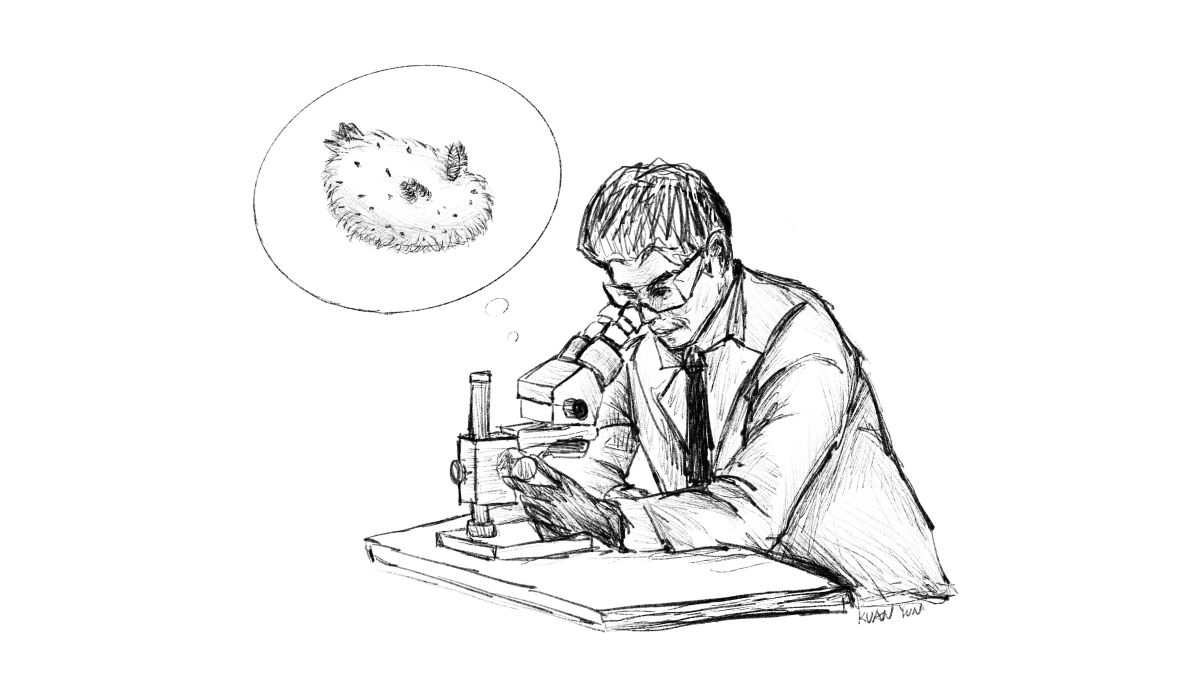NEWS
President's Letter
- Publish Date:2024-05-21
Breadth and Depth

The president studied the neural cells of the invertebrate sea hare using a microscope.
(Image credit: Kuan-Yun Chen)
(Image credit: Kuan-Yun Chen)
Narrated by NYCU President Chi-Hung Lin
Interviewed by Yen-Shen Chen, Written by Yen-Chien Lai
Interviewed by Yen-Shen Chen, Written by Yen-Chien Lai
Proofread by Yu-An Lu
______
From an Art Enthusiast to a Scientist
As mentioned in the first letter, during my university years, I particularly enjoyed photography and painting—interests often considered part of the arts and humanities. These pursuits seemed vastly different from my medical studies: one leaned towards the sensory, and the other towards the rational.
However, these artistic interests also guided my future research direction.
While studying for a Ph.D. at Yale University, I chose microscopy as my research field, focusing primarily on conducting experiments related to cellular dynamics and analyzing them through microscopy recordings. I was drawn to this specialization because of my passion for imaging technology and image processing during my high school and university years.
I worked alongside my advisor using advanced microscopy to study the changes and molecular mechanisms in the neuronal cells of invertebrates (sea hares) during motion. At that time, neurobiology research was still in its early stages, even in the United States. I mounted a camera on the microscope to capture the experimental results, reminiscent of shooting 8mm films back in school. However, cellular changes wait for no one, and the early equipment wasn't entirely up to par. I had to patiently monitor the microscope and imaging system, repeatedly conducting observation experiments. This often meant staying up late into the night, attending classes during the day, resting briefly at home after dinner, and then heading straight to the lab to work until dawn.
Looking back, I am still intensely interested in that "trial and tribulation" period in my research journey. The experimental videos I captured at that time were later included in biology textbooks on cellular motion, which gave me a great sense of accomplishment.
From a Starting Point to a Foothold
When I returned to Yang Ming University to teach after completing my doctoral studies, I began to explore the research direction I envisioned for myself, armed with my professional skills. Initially, my primary interest lay in cell biology. However, circumstances led me to join the newly established Rong Yang Genomics Team (榮陽基因體團隊), which required members with expertise in fluorescence microscopy techniques. Without hesitation, I joined the team and began utilizing comparative genomic hybridization (CGH) for chromosome research. Honestly, I had no prior experience in genetics research, so why did I join the team? It was because observing chromosomes for genetic analysis required different fluorescent labels, and my expertise in microscopy and optical processing proved invaluable.
Subsequently, my research scope gradually expanded into the realm of nanotechnology, and I developed a strong interest in the formation and metastasis mechanisms of colorectal cancer. In collaboration with my university classmate, Dr. Jeng-Kai Jiang, we proposed new hypotheses and evidence regarding the mechanism of colorectal cancer cell metastasis.
Looking back, my research topics have constantly changed and evolved, but my interests and professional background have always been integrated with different research directions. Maintaining enthusiasm and flexibility is the attitude I have developed in my research work.
From an Art Enthusiast to a Scientist
As mentioned in the first letter, during my university years, I particularly enjoyed photography and painting—interests often considered part of the arts and humanities. These pursuits seemed vastly different from my medical studies: one leaned towards the sensory, and the other towards the rational.
However, these artistic interests also guided my future research direction.
While studying for a Ph.D. at Yale University, I chose microscopy as my research field, focusing primarily on conducting experiments related to cellular dynamics and analyzing them through microscopy recordings. I was drawn to this specialization because of my passion for imaging technology and image processing during my high school and university years.
I worked alongside my advisor using advanced microscopy to study the changes and molecular mechanisms in the neuronal cells of invertebrates (sea hares) during motion. At that time, neurobiology research was still in its early stages, even in the United States. I mounted a camera on the microscope to capture the experimental results, reminiscent of shooting 8mm films back in school. However, cellular changes wait for no one, and the early equipment wasn't entirely up to par. I had to patiently monitor the microscope and imaging system, repeatedly conducting observation experiments. This often meant staying up late into the night, attending classes during the day, resting briefly at home after dinner, and then heading straight to the lab to work until dawn.
Looking back, I am still intensely interested in that "trial and tribulation" period in my research journey. The experimental videos I captured at that time were later included in biology textbooks on cellular motion, which gave me a great sense of accomplishment.
From a Starting Point to a Foothold
When I returned to Yang Ming University to teach after completing my doctoral studies, I began to explore the research direction I envisioned for myself, armed with my professional skills. Initially, my primary interest lay in cell biology. However, circumstances led me to join the newly established Rong Yang Genomics Team (榮陽基因體團隊), which required members with expertise in fluorescence microscopy techniques. Without hesitation, I joined the team and began utilizing comparative genomic hybridization (CGH) for chromosome research. Honestly, I had no prior experience in genetics research, so why did I join the team? It was because observing chromosomes for genetic analysis required different fluorescent labels, and my expertise in microscopy and optical processing proved invaluable.
Subsequently, my research scope gradually expanded into the realm of nanotechnology, and I developed a strong interest in the formation and metastasis mechanisms of colorectal cancer. In collaboration with my university classmate, Dr. Jeng-Kai Jiang, we proposed new hypotheses and evidence regarding the mechanism of colorectal cancer cell metastasis.
Looking back, my research topics have constantly changed and evolved, but my interests and professional background have always been integrated with different research directions. Maintaining enthusiasm and flexibility is the attitude I have developed in my research work.
The Benefits of Studying Extend Beyond Knowledge
In college, we sometimes complain about the practicality of learning specific fields of knowledge, but what sticks with me the most are the challenging journeys that require us to invest significant time and effort in learning and understanding. The rewards of learning go beyond what is found in books; the process of exploration itself is a form of training, teaching us how to handle the knowledge we encounter and how to accumulate experience in organizing and structuring that knowledge. This is the best interpretation of 'learning is endless.'
In the future, when faced with unexpected situations in clinical practice or research, we will often rely on the training we received during our student years to navigate through these bursts of information. This includes developing skills such as resilience, efficient learning, and decision-making. While it's acceptable to focus on specific topics due to time constraints, we should avoid limiting ourselves in terms of perspectives and methodologies. We shouldn't fear trying new things or experiences that are unfamiliar to us. It is essential to step out of our comfort zones, embrace learning, and seek guidance when needed. By pooling our collective wisdom and working together to solve problems, we can gain fresh insights.
Breadth and Depth: Which Is More Important?
Which is More Important: Breadth or Depth? Which Takes Priority? I've also faced criticism for frequently changing research topics and have been told that my scope is too broad and lacks depth, leaving me feeling doubtful and confused. However, in the end, those paths weren't taken in vain. Through this process, I gradually found my direction, and my broad interests and interdisciplinary learning became an advantage. In the future, integrating knowledge across fields will be more important than specializing in a single discipline because problems often require approaches from multiple angles, necessitating the collaborative use of different methods and interdisciplinary knowledge and skills. Therefore, I encourage young students to try solving real-world problems through interdisciplinary integration within limited resources (time, energy) and use this experience to identify their next topic.
In the era of AI, university education should focus on more than just specialized knowledge. We should maintain broad perspectives and avoid confining ourselves to classroom content. What AI technology will struggle to replace is the continuous interaction, discussion, and reflection between teachers and students, as well as among students themselves. Therefore, enhancing the depth of thinking is more crucial than the breadth and depth of learning. This will also be the invaluable essence of the university education environment.
Safe and healthy, may we all reap abundant harvests on our learning journey.
President of National Yang Ming Chiao Tung University,













